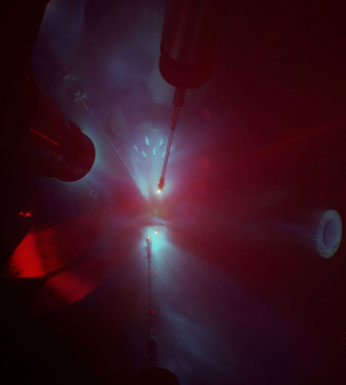Science Express article describes new clues to planetary evolution
 (Download Image)
(Download Image)
In the center of the target chamber at the OMEGA Laser Facility, a sample of material is struck with several high-power laser pulses at once. In a nanosecond, a material initially at low pressure and temperature, similar to the Earth's surface, is artificially heated and compressed to its natural state deep within a planet. This extreme state is quickly studied using probes and telescopes pointed at the target before it explodes into a cloud of dust and vapor.
The team's observations indicate substantial changes in molecular bonding as the magnesium oxide responds to these various conditions, including a transformation to a new high-pressure solid phase not previously observed. In fact, when melting, there are signs that magnesium oxide changes from an electrically insulating material like quartz to an electrically conductive metal similar to iron. Drawing from these and other recent observations, the team concluded that while magnesium oxide is solid and non-conductive under conditions found on present-day Earth, the early Earth's magma ocean might have been able to generate a magnetic field. Likewise, the metallic, liquid phase of magnesium oxide can exist today in the deep mantles of super-Earth planets, as can the newly observed solid phase.
"Our findings blur the line between traditional definitions of mantle and core material and provide a path for understanding how young or hot planets can generate and sustain magnetic fields," said McWilliams, who did his thesis research at LLNL while attaining his Ph.D. from UC Berkeley under Raymond Jeanloz.
Also participating in the studies were LLNL's Jon Eggert, Peter Celliers, Damien Hicks, Ray Smith and Rip Collins.
Contact
Breanna Bishop[email protected]
925-423-9802
Tags
Physical and Life SciencesFeatured Articles







